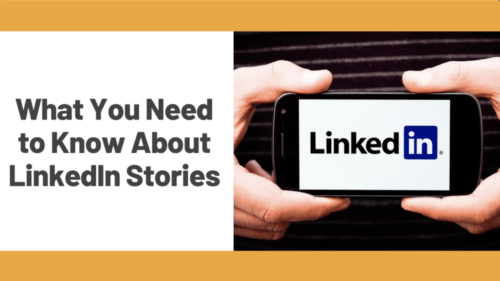
LinkedIn Stories: What You Need to Know About this New Feature

While LinkedIn is considered one of the primary social media channels within a comprehensive digital marketing plan, it differs from networks such as Facebook and Instagram. It’s more geared toward business-to-business (B2B) social networking for businesses and professionals.
Overall, LinkedIn offers an excellent platform for business owners and other professionals to establish themselves (and their businesses) as industry leaders and build strong engagement among their connections. Further, this network provides the opportunity to share content that reflects one’s company culture, products, expertise, services, and company updates, and connect with potential customers or employees.
Last week, LinkedIn rolled out a new, updated look. As part of this notable change, the professional social networking platform also launched LinkedIn Stories, making the feature available to all users for the first time.
As a business owner or professional who likely uses this channel for B2B communication within your business, organization, or even just for personal use, it’s important to stay up to date on the newest features and updates as they become available.
Read on to learn about three things you should know about the new LinkedIn Stories feature.
1. What are LinkedIn Stories?
Very similar to the stories features we’ve come to know and use regularly on Instagram, Facebook, and Snapchat, LinkedIn Stories are temporary visual updates (photo or video) that disappear after 24 hours. Per other platforms, LinkedIn Stories will now appear in a bar at the top of the main feed and show vertically, moving automatically from one to the next if the user has posted multiple updates in a row. Of course, they can be exited or clicked out of by the viewer if desired.
Simple editing features, such as adding text or stickers, are also available to enhance the photo or video being shared.
2. What is the goal?
One’s initial thought might be that a stories feature seems a little out of place on a professional networking site. On other channels that employ stories, the updates are usually more personal. However, stories have become an increasingly more popular way to consume content. Stories are typically more engaging and authentic for the viewer as well.
According to LinkedIn’s official blog, the network wanted to implement a new way for users to interact and communicate more casually in a professional context. In the blog, Pete Davies, head of Consumer Products at LinkedIn, stated, “Stories spread for a good reason: they offer a lightweight, fun way to share an update without it having to be perfect or attached to your profile forever.”
Adding this option to LinkedIn will also allow users to diversify the content they share on this channel and potentially reach a wider audience.
3. How to create LinkedIn Stories and types of content to share
Currently, the stories feature is only available on LinkedIn mobile. So, you’ll have to use your smartphone or another mobile device to create and share stories rather than your computer or laptop.
From there, creating is simple. Simply select the “+” icon above your story to capture a photo or up to 20 seconds of video. You also have the option to upload images and/or videos directly from your camera roll. Once the content has been captured or uploaded, you can add stickers and text. When you’re done, tap the “share story” button, and just like that, it’s live on LinkedIn.
Creating a LinkedIn story is relatively straightforward, but what types of content should you post? Continue reading for some examples.
- Share professional tips – Whether it’s done via a short video, a video series, or through a photo, graphic, or infographic, stories enable you to share tips, updates, advice, etc. in a fun and engaging way. By doing so, you can more strongly position yourself as an expert in your industry and provide value to your followers/connections.
- Upload real-time event or company updates – Since stories have a limited lifespan, they make for a good place to share real-time updates on events or other company happenings. These updates don’t have to be overly “produced” and can offer a quick, casual way to keep connections in the loop.
- Highlight products, services, and team members – Even though you may already be doing this within your feed, you can take showcasing products, services, team members, etc. a step further via stories. It’s more interactive and fun for your audience to watch and learn—the more “airtime,” the better.
What are your thoughts on LinkedIn Stories? Leave us a comment below!
Social media platforms like LinkedIn are continually changing and making updates. Sometimes, it can be challenging to keep up, but we’re here to help you posted.
Want to improve your business’ LinkedIn account, or need help managing other forms of social media and digital marketing? Contact us to see how we can best partner with you.
You May Like

The Importance of Setting Goals - for Career Success
Recently we had the opportunity to attend The Blue Chip Awards Luncheon. A wonderful afternoon filled with successful small business people, great food and inspirational stories, the highlight was key speaker, Nikki Stone. An Olympic gold medalist, Nikki overcame much adversity and physical challenges throughout her career and stressed the

Public Relations Strategy - 10 Steps to Ensure Success
As many of you know, I earned my APR (Accreditation in Public Relations) last year. Quite the process, I learned far more than I thought via studying assigned literature. One such piece, Cutlip & Center's Effective Public Relations 10th edition (EPR 10) was invaluable. Having practiced public relations for large

Networking: For Business and PR
Networking and communication used to take the traditional path of print advertising and brochures, direct mail, local/national trade shows, etc. These forms of communicating your brand/business still exist but more often they are used in balance with modern forms of networking and sharing information about you and your business. Here